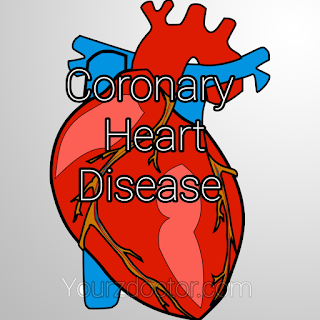Coronary Heart Disease
Coronary heart disease is also called
·
Ischemic heart disease
·
Coronary artery disease
·
Atherosclerotic heart disease
·
Atherosclerotic vascular disease
Introduction of coronary heart disease:
Ischemia
means decrease perfusion to the tissues.
Ischemia of the heart is called ischemic heart disease.
It
is due to the narrowing of the coronary artery due to atherosclerosis leading to
decrease oxygen, decrease nutrients, decrease waste excretion of the cardio
myocytes.
For
every cell, they require oxygen, nutrients, waste excretion for their normal
function. Due to blockage of the arteries, the oxygen, nutrients and waste
excretion is decreased which ultimately leads to the death of the cells
(necrosis).
More
than 95% myocardial infarction chances are in left ventricle due to its high pressure
produced
·
Pressure in left ventricle is 0 – 125
mmHg
·
Pressure in right ventricle is 0 – 25
mmHg
Increase
cardio myocytes quantity will increase pressure generation
What is coronary heart disease?
A
condition of narrowing of large / medium sized arteries supplying heart tissues
due to;
·
Etiological factors
·
Atheroma (atherosclerosis)
·
Inflammation
·
Spasm
What is ischemia?
Decreased
perfusion to the tissues.
What is perfusion?
The
flow of blood to the tissues, some tissues are high perfused
For
example: kidneys, liver, brain and heart
And
some are low perfused
For
example: bones and skin.
Due
to narrowing / blockage, ischemia
occurs, the cardio myocytes dies (necrosis)
Ischemia:
·
Low oxygen supply
·
Low nutrients
·
Low impaired waste products excretion
·
Increase free radicals (toxic to the
cell)
·
Low level of anti oxidants.
Due
to ischemia, cardio myocytes faces oxidation,
stress means waste products are formed these free radicals damages the
cells organelles.
Free
radicals such as
·
Lipid free radicals
·
Lipid per oxide
·
Superoxide
·
Hydroxide
·
Hydroxyl per oxide
If
the ischemia becomes completely (100% less perfusion) in infraction.
In
99% cases, ischemia occurs in left ventricle due to its increase thickness and
increase blood pressure (0 – 125 mmHg)
During
ischemia the adenosine is released and irritates nerves innervated in cardio
myocytes induce pain the indication signs appear we should go for lab
investigation.
But
in diabetes mellitus due to neuropathy adenosine cannot able to initiate pain the
sign indication is masked and difficult to diagnosis.
What is atheroma?
The
term used for the build up of material that adhere to the arteries.
What is atherosclerotic plaque ?
An
atheroma or atherosclerotic plaque is an abnormal and reversible accumulation
of material in the inner layer of an artery wall.
An
atheroma can be;
·
Atherosclerotic plaque (accumulation
of lipid plaque for example LDL-C)
·
Calcium deposition
What is atherosclerosis?
Atherosclerosis
is atheroma due to lipid.
What is artiosclerosis?
Artiosclerosis
is atheroma due to other than lipid.
What is artiolosclerosis?
Artiolosclerosis
is atheroma of the smaller arteries.
What is inflammation?
Inflammation
is damage the inner wall of the artery.
What is spasm?
The
spasm is the phenomenon of vasoconstriction and vasodilation under the
influence of nervous system, the nerves are innervated in the blood vessels.
The
imbalance between the supply of perfusion and the demand of the perfusion results
in myocardial infarction.
Composition of the atherosclerotic atheroma / composition
of atherosclerotic plaque:
·
LDL composition
·
Attraction of monocytes
·
Foam cell generation
·
Inflammation
·
Thrombus
Risk factors for coronary heart disease:
There
are two types of risk factors for coronary heart disease
1. Modifiable
Risk factors for coronary heart disease
2. Non
Modifiable Risk factors for coronary heart disease
Modifiable Risk factors for coronary heart disease:
·
Obesity
·
Smoking
·
Physical inactivity
·
Diabetes mellitus
Non Modifiable Risk factors for coronary heart disease:
·
Neuropathy
·
Male gender
·
Menopause
Read More
Searching Tags
What
is coronary heart disease?
What
is ischemic heart disease?
What
is coronary artery disease?
What
is atherosclerotic heart disease?
What
is coronary heart disease?
What
is atherosclerotic vascular disease?
Introduction
of coronary heart disease
Definition
of coronary heart disease
What
is coronary heart disease?
What
is ischemia?
Conditions
for ischemia
Free
radicals involve in coronary heart disease
What
is atheroma?
What
is coronary heart disease?
Types
of atheroma
What
is atherosclerosis?
What
is artiolosclerosis?
What
is artiosclerosis?
What
is inflammation?
What
is coronary heart disease?
What
is spasm?
Composition
of atherosclerotic plaque
Composition
of atherosclerotic atheroma
What
is coronary heart disease?
Risk
factors for coronary heart disease
Types
of factors for coronary heart disease
Modifiable
factors of coronary heart disease
Non
modifiable factors of coronary heart disease
What
is coronary heart disease?






0 Comments